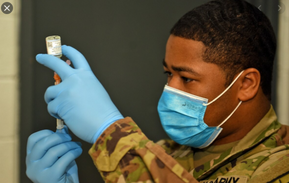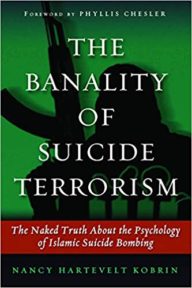
Cash, COVID, and Cover-up, Part 2: The Gain-of-Function Controversy … PLUS …
THE BLAZE | By Leon Wolf and Chris Pandolfo | September 1, 2021
It is not accurate to say that Dr. Anthony Fauci has never faced tough or aggressive questioning during this pandemic. Although he has largely been fêted uncritically by the legacy media, he has on occasion faced tough or aggressive questioning when, for instance, he has been called to testify before angry Republican members of Congress, and in occasional interviews, he has been confronted regarding public health experts’ flip-flopping on the desirability of wearing face masks. And Fauci is certainly aware of criticism that has been raised against him online, because he often responds to it (albeit usually in friendly forums).
In all the times, however, that Fauci has been publicly questioned or doubted, he has kept his cool. At most, he has slightly raised his voice and spoken insistently, but he has generally not allowed his temper to show.
Except once.
On that one occasion, Fauci was testifying before a Senate Health Committee hearing, and his one singular explosion came in response to a question posited to him by Republican Sen. Rand Paul of Kentucky:
Rand Paul just confronted Dr. Fauci over gain of function research and triggered him so bad that he started yelling https://t.co/eHibcZnR9J— Caleb Hull (@Caleb Hull)1626795379.0
The specific suggestion that finally sent Fauci over the top was the idea that gain-of-function research, which was funded by the NIH, may have caused the pandemic. While the exchange was briefly noted on social media because of the unusual fervor of Dr. Fauci’s response, it largely passed beneath the waves of public attention. That is because, until very recently, almost no one outside the scientific community understood what gain-of-function research is or why it matters.
As the testy exchange between Fauci and Paul suggests, Fauci and his agency have engaged in some extremely fine hair-splitting about what, exactly, constitutes gain-of-function research. In bureaucrat-ese, it is entirely possible that Fauci believed he was answering Paul’s question truthfully because of some obscure distinction that would be lost on the average person.
For the purposes of this article, we will use Dr. Paul’s definition, which is the definition the ordinary person would attach to it: namely, any research that intentionally makes viruses more transmissible among mammals, and particularly among humans.
The ordinary person, for that matter, would likely be shocked that this kind of research has been going on at all. Probably, the ordinary person would be horrified to learn that for years, scientists have been monkeying around with deadly viruses that exist in nature for the express purpose of making them capable of infecting human cells. Scientists, however, have claimed that such research is necessary to allow them to develop treatments and preventive vaccines for these viruses, assuming that some of them will inevitably make the evolutionary jump to become transmissible among humans.
Whatever the possible benefits of gain-of-function research, it obviously comes with risk. And one particular experiment, conducted in 2011, involved so much obvious risk that even many research scientists began to raise the alarm about the possibility of a catastrophe if a lab accident occurred.
The research, which was funded by the National Institutes of Health and conducted in Rotterdam, Netherlands, and at the University of Wisconsin, involved experiments on the H5N1 strain of avian influenza, which had an astonishing estimated 60% fatality rate. The scientists involved had successfully made the virus transmissible via respiratory droplets among ferrets, which were the best simulation for human transmissibility. It was the first time this deadly bird flu was able to cause airborne infections in mammals.
As the Washington Post detailed in its in-depth examination of gain-of-function research and the safeguards on it that were established — and subsequently undercut by Fauci and NIH Director Francis Collins — the bird flu experiments caused immediate concern. A peer reviewer of the confidential study flagged the experiments for the Obama administration, observing that if the details of these experiments were published, they could “provide a recipe for terrorists.”
Collins’ staff at the NIH assigned the agency’s biosecurity board to assess the risk from these experiments. Another of the scientists interviewed by the Post, who at the time served as chairman of the board, recalled that his colleagues were worried about publishing the gain-of-function study, since “you could kill 4 billion people in a flash, because these viruses go around the world.”
On Nov. 30, 2011, the board unanimously recommended that the “general conclusions” of the experiments be published but without “details that could enable replication of the experiments by those who would seek to do harm.”
“Fauci and Collins responded by working privately to reverse the biosecurity board’s recommendation — while publicly defending the need for the research, according to interviews and records,” the Post reported last week.
Indeed, Fauci, Collins, and their colleague Gary Nabel co-wrote an op-ed in the Washington Post defending the gain-of-function research, arguing the dangerous experiment was worth the risk and that “the scientists, journal editors and funding agencies involved are working together” to limit knowledge of how to engineer a deadly pathogen “to those with an established and legitimate need to know.” They argued that such experiments would be conducted in high-security labs, with safeguards to protect against accidental release.
The bureaucrats successfully lobbied the board to reverse its earlier recommendation, and after that, the full H5N1 gain-of-function study was published without redactions. From his position as director of the NIH’s National Institute of Allergy and Infectious Diseases, Fauci, in the years following, continued to throw support and taxpayer funding behind gain-of-function research projects.
But the publication of the study ignited heated debate in the scientific community over gain-of-function research, and pressure began mounting on the Obama administration to cut off federal funding for such experiments. The Department of Health and Human Services moved in 2013 to establish more oversight over NIH funding for such experiments, creating a committee that would review research proposals referred to it by the NIH. The contempt Collins and Fauci had for oversight of their work can be noted by the dismissive name they assigned to the new oversight board, which was dubbed the “Ferrets Committee” by Collins.
Additionally, high-profile lab accidents during this time involving anthrax and smallpox, as well as the Ebola virus scare in 2014, convinced the Obama White House that gain-of-function experiments were too controversial to continue. In October 2014, the administration announced a moratorium on funding for gain-of-function research for influenza, SARS, and MERS viruses.
And the leading expert on coronaviruses in the United States, if not the world, realized at that moment that federal funding for the gain-of-function experiments in his North Carolina lab had just dried up.
+++++++++
Dr. Ralph S. Baric is the William R. Kenan Jr. Distinguished Professor in the Department of Epidemiology and Professor in the Department of Microbiology and Immunology at the University of North Carolina. As a world-renowned virologist and leader in the research field of coronaviruses, animal models, antibodies, and mutant strains of viruses developed in his lab are used in coronavirus labs around the country. A colleague once described Baric to NPR as “the big cheese” in his field.
He’s authored hundreds of scientific papers and since 1986 has received more than $93 million from NIAID to fund his various research projects. Baric’s work has included gain-of-function experiments, though he has repeatedly insisted over many years that he has never created new, more dangerous versions of viruses that can infect humans in his lab.
When the Obama administration’s moratorium on gain-of-function research went into effect, Baric was working on several projects in his lab. “It took me 10 seconds to realize that most of them were going to be affected,” he told NPR in November 2014.
Baric and others in his field pushed back against the federal government’s decision. As the Post reported, he wrote to the NIH’s biosecurity board that November that gain-of-function experiments “are a documented, powerful tool” for developing public health intervention methods to contain and control a potential pandemic. The goal of his research was to develop a universal vaccine that would protect against all potential viruses related to SARS. In his lab, he created artificial SARS-like viruses to explore how coronaviruses in the wild might evolve to attack human cells and study how vaccines might be developed that could teach human immune cells to fend off SARS-like diseases.
His arguments reached sympathetic ears at the NIH. Baric’s work received an exemption, and his various projects were allowed to proceed with federal funding.
Among those projects was a collaborative effort with China’s “bat woman,” Shi Zhengli, a lead researcher at the Wuhan Institute of Virology. For years, Shi’s team had worked in the field to collect coronavirus samples from bat species. In 2012, her researchers collected a virus called RaTG13, which scientists now believe is the closest known relative of the SARS-CoV-2 virus that causes COVID-19. It should be noted that Shi did not call it RaTG13 at the time — but more on that later. She had also discovered the genome of another new virus called SHC014, a close relative of the original SARS virus.
A June report from the MIT Technology Review recounted how Baric approached Shi in 2013 after a meeting and asked her for the genetic data on SHC014. He wanted to take the “spike” gene from SHC014 and transplant it to a copy of the SARS virus he already possessed in his lab. Doing so would create a new chimeric virus that would demonstrate whether the spike protein of SHC014 was capable of attaching to human cells. Shi agreed to collaborate, and the two scientists began working together.
“A SARS-like cluster of circulating bat coronaviruses shows potential for human emergence” was published by Baric and Shi in 2015. Using mice as test subjects, the researchers “generated and characterized a chimeric virus” by inserting the spike protein from SHC014, a Chinese rufous horseshoe bat virus, into the molecular structure of the 2002 SARS virus, creating a new pathogen. The acknowledgments of the study noted it was funded with grant money from Fauci’s NIAID and that “experiments with the full-length and chimeric SHC014 recombinant viruses were initiated and performed before the [gain-of-function] research funding pause and have since been reviewed and approved for continued study by the NIH.”
Five years after the publication of this study in Nature Medicine, on May 22, 2020, a stunning correction was added to Baric’s paper revealing that the viral sequence for the mouse-adapted SHC015-MA15 virus had not been deposited in the NIH’s genetic sequence database at the time that the study was published. Incredibly, the article was published without that genetic sequence, in apparent contradiction of the journal’s reporting standards.
Dr. Baric did not respond to a request for comment from TheBlaze on why he waited five years to make this correction.
A spokesperson for Nature Medicine said, “Maintaining the integrity of the scientific record is of primary importance to us as and as soon as we became aware of this issue we worked with the authors to publish a correction.”
+++++++++
Baric’s gain-of-function work was not the only study granted an exemption by the NIH. The Obama administration’s moratorium contained a clause granting exemptions “if head of funding agency determines research is urgently necessary to protect public health or national security.” At NIH Director Collins’ discretion, virtually every gain-of-function study that applied for an exemption reportedly received one. The moratorium existed only on paper, and officials at the NIH worked behind the scenes to have even those illusory restrictions on funding gain-of-function studies revoked.
They succeeded in 2017, when the long-ignored moratorium was officially lifted by the Trump administration. It was replaced with a new HHS oversight body called the Potential Pandemic Pathogens Control and Oversight (P3CO) Framework. This review board is supposed to critically evaluate requests for federal funding for research projects that involve enhancing deadly pathogens. But an April report from the Daily Caller revealed that some NIH research grants were evading review by the P3CO Framework.
Specifically, Fauci’s NIAID awarded $600,000 to the nonprofit group EcoHealth Alliance, which then provided that U.S. taxpayer money to the Wuhan Institute of Virology to fund Shi’s bat coronavirus research.
That award to EcoHealth Alliance and its transfer to the Wuhan lab have been the subject of Sen. Rand Paul’s various tense exchanges with Fauci when the NIAID director testified before the U.S. Senate. In one exchange in March, Fauci stated under oath that the “NIH has not ever, and does not now, fund ‘gain of function research’ in the Wuhan Institute.”
But that’s not what State Department officials believe.
In late 2017, the State Department sent health and science officials from the U.S. Embassy in Beijing to Wuhan to investigate the WIV’s lab conditions after learning that Chinese researchers had discovered several new viruses in bat caves. These viruses had a spike protein that could potentially make them dangerous to humans, and U.S. officials were concerned that gain-of-function experiments were being conducted in the newly designated top-level biosafety laboratory (BSL-4) in Wuhan, Josh Rogin reported for Politico.
The embassy’s team met with Shi and would later report in a 2018 cable that the Wuhan lab “has a serious shortage of appropriately trained technicians and investigators needed to safely operate this high-containment laboratory.”
U.S. government officials would come to believe that Chinese labs were performing gain-of-function experiments “on a much larger scale than was publicly disclosed,” according to Rogin.
How did this happen? Well, after Shi collaborated with Baric between 2013 and 2015, the Chinese scientists on her team used the techniques she learned from Baric to continue gain-of-function studies on their own. Baric’s lab at UNC and Shi Zhengli’s at WIV became “more like competitors,” with both “in a race to identify dangerous coronaviruses, assess the potential threat, and develop countermeasures like vaccines,” according to the MIT Technology Review.
The problem is that Shi’s lab in Wuhan did not share the same safety protocols as Baric’s lab in the U.S. observes, as the State Department determined in its 2018 cable. And the Chinese government isn’t exactly transparent about the work its scientists are doing. If the Wuhan lab conducted gain-of-function experiments under unsafe conditions, the Chinese wouldn’t report that fact to the international community.
+++++++++
Against this backdrop, virologists in the United States confronted the emerging COVID pandemic in late 2019 and early 2020. And a cadre of scientists who had, for years, pooh-poohed the potential dangers of the research they had conducted and/or funded were met with an explosive revelation: A group of researchers, led by respected virologist Kristian Andersen, Ph.D., had studied the emerging genetic sequence of SARS-CoV-2 (the virus that causes COVID-19) and had determined that it looked “potentially” genetically engineered.
Andersen’s email, which was sent on Jan. 31, 2020, at 10:32 p.m. to Fauci and Jeremy Farrar, stated, “On a phylogenic tree the virus looks totally normal and the close clustering with bats suggest that bats serve as the reservoir. The unusual features of the virus make up a really small part of the genome (<0.1%) so one has to look really closely at the the sequences to see that some of the features (potentially) look engineered.”
Andersen’s email to Farrar and Fauci set off a flurry of activity that will be discussed in great detail in the next part of this series, but before examining how the relevant scientists reacted, it is important to examine why.
Fauci, in particular, had been arguing publicly for years that gain-of-function research was safe, and he had furthermore acted to circumvent oversight of such research in ways that might provoke some uncomfortable questions, as demonstrated by the number of government agency heads who stonewalled Washington Post reporters who sought to assess exactly how much oversight had occurred over gain-of-function research during Fauci’s tenure.
If it turned out that this virus was, indeed, the result of a laboratory accident in a lab conducting a type of research that Fauci and others had been publicly insisting was safe, then the recriminations would be very severe indeed.
And if, even worse, that research had funded by a grant approved by Fauci’s agency, the end of that particular play would not be hard to predict: Not a single red cent would ever be allocated to anyone, public or private, for this kind of research for a long time — maybe ever again. In fact, forget whether such research would ever be funded, it might well become illegal. If the public at large became aware that scientists had been doing bizarre research to make viruses significantly more deadly than COVID transmissible, there is no telling how difficult the unwashed bureaucrats who were responsible for the tiresome “Ferrets Committee” might make all their lives.
And so, faced with the threat of the extinction of their entire profession, the world’s prominent virologists, joined by the man who was responsible for funding so many of them, sat down to formulate a response.


















